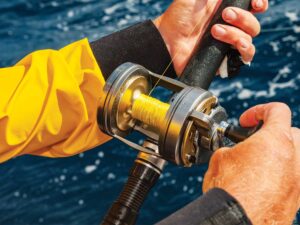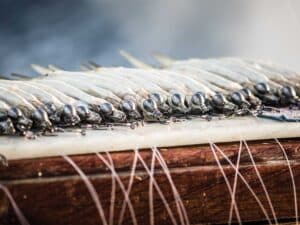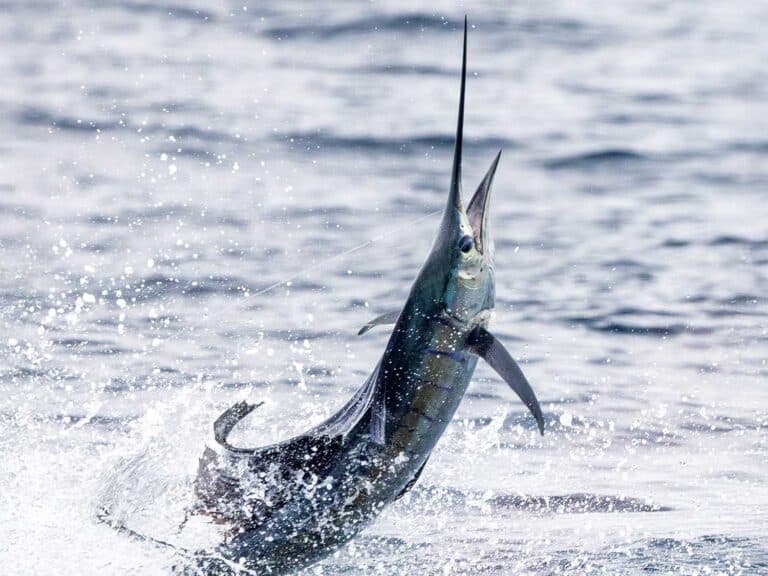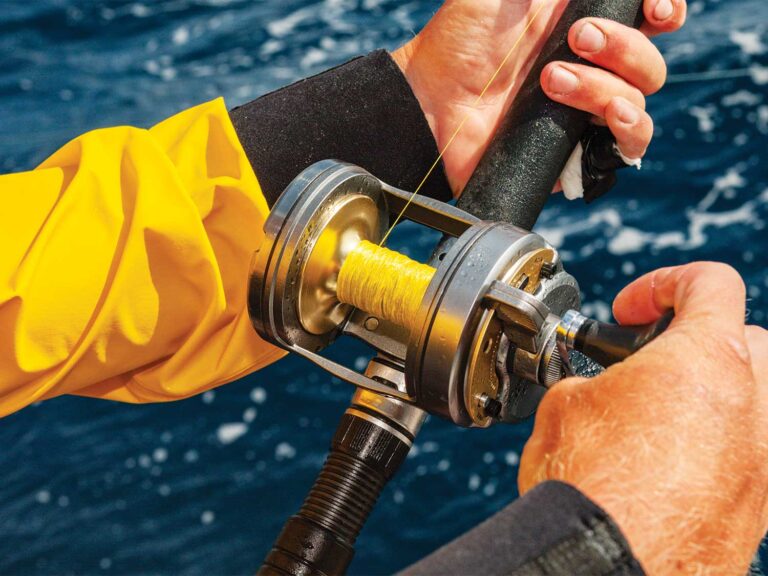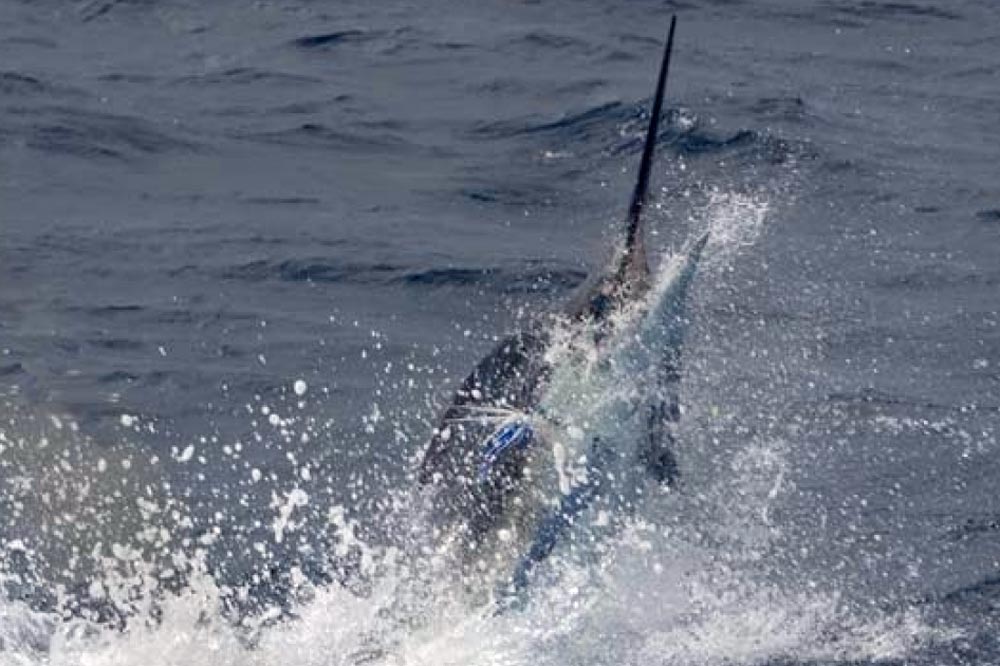
Keeping them on
If you hook a fish properly, and the line doesn’t break, you should eventually catch it. Of course, the angler or crew can make a serious error that results in a lost fish, or the fish just may be too big for the tackle used and manage to break free. Most lost fish, however, take a bit of drag and then pull the hook. This leaves you wondering: Is there something that I, or the angler, could have done differently to keep that fish on? Hooking the fish, and keeping it hooked until it can be gaffed or tagged and released, is the most essential, and one of the most challenging, parts of fishing.
**
Dead Baits**
When targeting billfish using dead natural baits, there are several things that you need to do — and a few that you need to avoid — in order to be successful. First and foremost, giving a good drop-back with true free-spool, where the line falls off the rod tip, is an essential skill that must be learned by all anglers.
Other essential fine points include how the crew rigs the bait and the freshness and condition of the bait. The fresher the bait, the less likely it is that a fish will tear the bait off the hook on the initial strike, leaving the angler with no chance of a second shot at the fish. All of your dead baits should either be fresh or brined, then flash frozen in an “as good as fresh” condition.
One problem you often encounter when pulling dead bait is having the hook turn around and get fouled in the bait, either before or during the strike. The chance for a solid hookup with the hook point buried in the bait is close to zero, regardless of how skillfully the angler executes the drop-back.
This problem becomes more common when using dead or live baits rigged on a bridle that goes through the bait’s eye sockets. If you put too much slack in the bridle, it will allow the hook to move around or along the bait’s head and gills. This is especially true when trolling big baits in rough water on the down-sea tack. The constant, abrupt changes in speed from surfing quickly down a wave and then slowing down as it passes under can jerk the bait around and cause it to foul up.
Any bait with the hook swinging freely several inches ahead of its nose may become fouled while inside a marlin’s mouth or gut. If the hook gets buried in the bait instead of the marlin, you can pull the bait all the way out without any real chance of hooking the fish.
Whippy, fiberglass outriggers, without stays and guy wires, may exacerbate the problem by jerking the bait free of the water as the boat changes speed. Once the bait digs into the water a bit when the boat slows, it applies more pressure on the rigger, and pent-up energy in the rigger flings the bait out of the water when the boat speeds up again. The bait commonly lands with several feet of slack line, which then comes tight again with a jerk. All too frequently this results in a foul-hooked bait that won’t troll properly and will not hook a fish even if it gets eaten.
The most common and easiest solution to the problem is to tie the hook down very tightly to the bait, with the bend of the hook held tight to the middle of the bait’s skull. When using live baits, you can do this by sliding the bridle down near the barb of the hook, and spinning the point of the hook under any excess length of bridle. (A lot of crews use rubber-band bridles on smaller live baits to solve the problem as well.) This becomes slightly more difficult when using larger live baits such as small tuna — which are commonly rigged with loops of 130 Dacron — but it still makes a much better solution than using a long bridle with a free-swinging hook.
Since you use a light, thin bridle, made of braided Dacron or Spectra, the fish should be able to shed the bait on its first jump or head shake. But there’s a fine line here: The crew must be careful not to make the bridle so weak that it breaks on the strike, yet not so strong as to withstand a lot of jumps that it can unhook the fish while flopping around on the hook.
When using dead baits, the mate doesn’t have to get a live fish back in the water quickly, so he can spend more time rigging and stitching the bait. Instead of using a looped bridle of Dacron, the mate uses a series of cross-stitches with Dacron or waxed nylon rigging twine to hold the hook tightly in place against the bait’s skull.
Top crews constantly search for innovative solutions to attaching large dead or live baits to their hooks that result in the best hookup percentage. Lately, I’ve seen several crews using short pieces of plastic tubing that hold the hook about an inch or so in front of the bait. This provides good separation from the head for a better hookup, while eliminating the free-swinging hook that may turn around and foul itself in the bait.
On the Bite
Do not ever gun the boat to try and set the hook. The worst possible hookup ratio comes when you pull the line tight while the fish is pointed toward the boat. You usually end up jerking the bait right out of its mouth. Even a deeply hooked fish can come loose if you’re pulling hard with the pointy end facing the boat.
That holds especially true when using circle hooks, which have now been proven time and again to result in overall higher capture averages than J hooks. Even so, if you do not let the fish eat and turn away from the boat, you will have a hard time hooking the fish on a circle hook.
But the same can be said for all hook styles — they all work best on a fish moving away from the boat — or with the pressure pulling from at least a 90-degree angle to the fish’s direction of travel. When fishing live baits, many top crews provide “drop-back” by backing up — and may even retrieve line while doing so, to try and make sure the fish is swimming away from the boat when it first comes tight.
When a marlin eats a big tuna — alive or freshly dead — and becomes hooked in either the jaw or the corner of the mouth, the weight and momentum of the large bait swinging wildly as the fish jumps around may unhook the fish. This is one scenario where lures hold an advantage over dead bait.
When a fish eats a lure, the lure slides back to the end of the trace leader and, rather than unhooking the fish, actually helps keep the line tight as it’s dragged backward through the water. Never run ahead to get tight on a marlin hooked on a lure — the last thing you ever want to do is pull from the front of a marlin hooked on a lure.
Tight Line Boat Handling
In the earliest stages of a fight, when there’s a lot of line out and the fish is moving fast and away from the boat, a belly in the line becomes the angler’s worst enemy. Too much line out, and a fast-moving fish is a recipe for disaster. Once the fish starts taking off, the skipper needs to move the boat immediately to stop or slow the loss of line. At the same time, the angler needs to back off the strike drag. A long length of line moving through the water creates an incredible amount of drag on its own, so if the angler doesn’t back off the drag, a sudden acceleration on the fish’s end could break the line — even at a drag setting well below the line’s breaking strain.
Chasing the fish in forward gear saves losing line and gets line back quicker and easier than merely “backing down” on a hot fish. The same belly that was a source of danger at the start of the fight becomes the team’s best friend when the fish swaps ends and jumps wildly toward the boat.
No angler can even come close to retrieving line fast enough to stay tight to any billfish running and jumping toward the boat. In this situation, many captains mistakenly run straight away from the fish to try to tighten the slack line. It’s the wrong move. Once the fish charges the boat, it’s already too late to start moving ahead; the line is already slack once you start to move, and you won’t get any benefit from the action. Even a sluggish or mortally wounded fish can change direction much faster than the most agile boat ever built.
A far better maneuver is to move the boat at right angles to the fish, introducing a larger belly, which puts enough strain on the line trailing behind the fish to keep the line tight. The pressure on the hook is now pulling back into its jaw, not out the front of its open mouth. As the fish gets closer to the boat, idle ahead on a parallel course. The angler should be rapidly retrieving line during this entire maneuver.
When the fish pulls up alongside the boat, the captain should speed up to match the fish’s speed and course. Turn partly away from the fish if you think running over the line is a possibility and ease closer to him if the belly is over, say, 100 yards.
Executing the actions described has allowed us to catch hundreds of jaw-hooked marlin and tuna over 800 pounds in under 20 minutes — some in as little as 10 minutes, or in even less time than that.
Nose Jobs
A marlin that tries to eat a lure or bait but comes away with the hook hung on its bill is what we call a “nose job.” This happens most commonly when using artificial lures. If you ever pull on the fish from directly in front of it when it has the hook wrapped on the bill, the hook will almost certainly slip off, since the bill is much thicker at the base and gets skinnier closer to the tip.
Many seasoned captains inspect the inside of the bend in any J-hook that “pulled” during a fight. Even if you never saw the fish eat the lure, a crop of new scratches on the inside of the bend tells the crew that they lost a marlin. Some top skippers even wrap tape around the bend of the hook to make the telltale scratches more apparent.
If I suspect, either from a fish’s behavior or from seeing the lure’s location on a jump, that it may not be hooked properly but just has the hook jammed onto the bill, I fight it differently.
When the fish is nose-wrapped, you have to try hard to always stay behind the fish — a tactic that constantly jams the hook even farther up onto the bill. If we pull directly against the hook, from in front of the fish, no matter how close or far away from the fish we are, the hook is very likely to slide off the bill. If we do not get a tag or a gaff into the fish before the hook slides off, then the fish is lost.
Line belly becomes your friend when you’re fighting a fish with a nose job. Deliberately keeping a belly in the line keeps the pull of the line along the fish’s side and past its tail. This is one of the few times that having a fish get tail-wrapped is actually to your advantage.
In the later stages of the fight, when the fish is close to the boat, we may even loosen the drag while trying to back up to a position behind the fish. If the fish stays on the surface and swims away from us, we will pull harder on the line or leader but let go of the leader or back off the drag if the fish starts to turn.
I can remember many nose jobs, both caught and lost, but one of my favorites was one that I had on with Skip and Kunta Smith while fishing on Hooker in the Poco Bueno tournament down in Texas. That nose-job fish took first place in the tourney and won us a lot of money because we deliberately took her “going away.”
